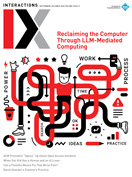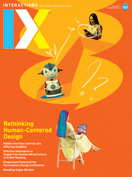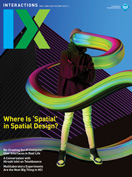Authors:
Elizabeth F. Churchill, Mikael Wiberg
Welcome to the September–October issue of Interactions. In it, we cover ACM's move to open access, LLM-mediated computing, and ergonomic design alternatives to one of the most ubiquitous interaction modalities—the computer mouse.
Most Interactions contributors and readers will have heard that ACM is going to move to a new publishing model in January 2026, transitioning to fully open access for all its publications. This shift will take ACM from a pay-to-read to a pay-to-publish model for its digital library. ACM President Yannis Ioannidis offers his perspective on this development. This is a significant change for publishing, so we encourage everyone involved with Interactions to review this article carefully.
In more regular content—our cover story, "Reclaiming the Content Through LLM-Mediated Computing"—Mattias Rost argues for a new paradigm in computer design and use: LLM-mediated computing. Rather than jumping between engagement-driven applications, users can simply state their intent and the computer will carry it out. "Instead of opening an email client, the user might say, 'I need to reply to this message,' and a writing space would appear. Instead of working in spreadsheets, we might work with the numbers directly, letting the computer deal with formulas and computation where it is needed," Rost writes. In his view, this is a vision of technology that moves beyond app-driven friction toward a more humane, responsive digital environment.
Speaking of humane, in "Flexible Ergonomics: Can a Flexible Mouse Fix That Wrist Pain?" Jose Berengueres and Tony Yu address the fact that the computer mouse, while being an HCI device many of us use daily, is also a persistent source of pain for some people. The authors showcase ergonomic alternatives they've designed to encourage more-natural hand movements, grounded in their key insight that hands are highly flexible, not rigid blocks. By shaping devices to move with the hand rather than force it into fixed positions, they call for making ergonomic tools far more effective.
Recent articles (http://bit.ly/46Kl46N) have highlighted the potential harm young people can experience when they form deep emotional attachments to AI companions. In her column, Jie Li explores ways to prevent such outcomes, especially for children who are growing up with LLMs. Speaking with Alexandra Diening, research scientist and cofounder of the Human-AI Symbiosis Alliance, she imagines a future in which some of these children might have romantic relationships as young adults both with AI systems and with people. Li offers a set of strategies for parents to help safeguard their children's well-being: raising awareness about anthropomorphism, designing LLMs to avoid constant flattery, and strengthening support for young people's mental health and emotional resilience.
We're also excited to introduce our new columnist, Ovetta Sampson, who brings two decades of experience in AI design to the role. In her first Transforming Research and Design column, she examines the costs of AI systems, including water and energy consumption. "Cooling one large data center takes about 132 gallons of water a day—that's equal to the amount used by 4,200 people in the U.S.," she notes. In the coming months, she plans to explore what she sees as three major risks posed by AI development: acceleration of climate change, diminishing labor opportunities, and disruption of human cognitive function.
Finally, in Exit, Scott Minneman and Renato Verdugo share David Szauder's work in "Algorithmic Authenticity: David Szauder's Visionary Practice." As an artist, Szauder fuses digital techniques, including AI-generated content, with his artistic vision to create layered, thought-provoking animations and visuals that evoke provocative and dreamlike otherworlds. Harking back to an Interactions cover story from two years ago, "Is AI Going to Replace Creative Professionals?" (http://bit.ly/4mexXeg), by Bhautik Joshi, work by artists such as Szauder helps us examine the relationship between technology and art more deeply.
As we begin outlining Interactions issues for 2026, please consider submitting an article. You can find information regarding our submissions guidelines at https://interactions.acm.org/submissions.
Elizabeth F. Churchill and Mikael Wiberg
[email protected]
Copyright held by owners/authors
The Digital Library is published by the Association for Computing Machinery. Copyright © 2025 ACM, Inc.







Post Comment
No Comments Found